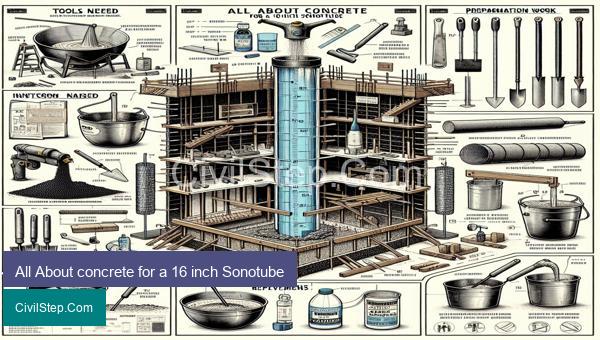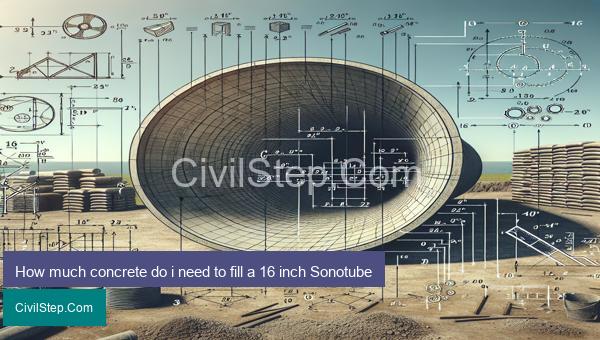
Concrete is an essential building material that has been used for centuries in various construction projects. It’s known for its durability and versatility, making it a top choice for builders and architects. One specific use of concrete is for building strong and sturdy foundations, and this is where the Sonotube comes into play. A Sonotube is a cylindrical form made of cardboard used for creating concrete columns or footings. In this article, we will delve into all things concrete for a 16 inch Sonotube, including its benefits, uses, and how to properly use it for your construction needs. Whether you’re a seasoned builder or a DIY enthusiast, this article will provide you with valuable information on all you need to know about concrete for a 16
How much concrete do i need for a 16 inch Sonotube

As a civil engineer, I am often tasked with determining the amount of materials needed for various construction projects. One common material used in many construction projects is concrete, which is a versatile and durable material that is used in foundations, columns, walls, and other structural elements. In this article, I will discuss the amount of concrete needed for a 16 inch Sonotube.
Before we can calculate the amount of concrete needed, it is important to understand what a Sonotube is and its purpose. A Sonotube, also known as a concrete form tube, is a cylindrical cardboard tube that is used to create cylindrical structures such as columns and footings. It is a cost-effective and efficient method of forming concrete structures. Sonotubes come in various sizes, with the most common diameter being 16 inches.
To determine the amount of concrete needed for a 16 inch Sonotube, we first need to calculate the volume of the tube. The volume of a cylinder can be calculated using the formula V = πr²h, where “V” is the volume, “r” is the radius, and “h” is the height. In this case, the radius is half of the diameter, which is 8 inches. The height of the tube can vary, depending on the desired height of the structure. For this example, let’s assume the height of the Sonotube is 4 feet or 48 inches.
Using the formula, we can calculate the volume of the 16 inch Sonotube:
V = 3.14 x (8 inches)² x 48 inches
V = 3.14 x 64 square inches x 48 inches
V = 24,883.2 cubic inches
Since we typically measure concrete in cubic yards, we need to convert the volume from cubic inches to cubic yards. There are 46,656 cubic inches in a cubic yard, so we can divide the volume by this number to get the volume in cubic yards:
24,883.2 cubic inches ÷ 46,656 cubic inches/cubic yard = 0.534 cubic yards
Therefore, we will need approximately 0.534 cubic yards of concrete for a 16 inch Sonotube with a height of 4 feet.
It is important to note that this calculation is only an estimate and the actual amount of concrete needed may vary depending on other factors such as the thickness of the concrete and any voids inside the tube.
In conclusion, as a civil engineer, I know that calculating the amount of materials needed for a construction project is crucial for its success. When it comes to concrete, accurately calculating the amount needed for a 16 inch Sonotube is important to ensure the structure is strong and stable. By using the appropriate formula and taking various factors into consideration, we can determine the estimated amount of concrete needed, making the construction process more efficient and cost-effective.
How much concrete do i need to fill a 16 inch Sonotube

To determine the amount of concrete needed to fill a 16 inch Sonotube, we must first understand what a Sonotube is and its purpose in construction. A Sonotube, also known as a concrete form tube, is a cylindrical form made of heavy-duty cardboard used to create round columns or piers in construction projects. It is typically used for its ease of use, cost-effectiveness, and ability to create consistent concrete columns.
Step 1: Calculate the volume of the Sonotube
The first step in determining the amount of concrete needed is to calculate the volume of the Sonotube. The volume can be calculated using the formula for the volume of a cylinder, which is V = πr²h, where V is the volume, π (pi) is approximately 3.14, r is the radius of the tube, and h is the height of the tube.
For a 16 inch Sonotube, the radius (r) is half of the diameter, which is 8 inches. The height (h) can vary depending on the specific project, but for this example, we will assume a height of 4 feet (48 inches).
Now, plugging in the values into the formula, we get V = 3.14 x 8² x 48 = 12,179.2 cubic inches.
Step 2: Convert the volume to cubic feet
Most construction measurements are done in feet, so we need to convert the volume from cubic inches to cubic feet. There are 12 inches in a foot, so we divide the volume by 12³ (12 x 12 x 12) to get the volume in cubic feet. Therefore, the volume of the 16 inch Sonotube is equal to 12,179.2 / 12³ = 0.59 cubic feet.
Step 3: Determine the yield of concrete
Different types of concrete have different yields, which is the volume of concrete that a given quantity of ingredients will produce. The most common type of concrete used in construction is standard concrete, which has a yield of 27 cubic feet per cubic yard. This means that one cubic yard of standard concrete will cover 27 cubic feet.
Step 4: Calculate the amount of concrete needed
To calculate the amount of concrete needed, we divide the volume of the Sonotube by the yield of concrete. In this case, the amount of concrete needed is 0.59 / 27 = 0.022 cubic yards.
Therefore, to fill a 16 inch Sonotube with a height of 4 feet, you will need approximately 0.022 cubic yards of standard concrete.
It is always recommended to account for some extra concrete, as there may be some minor variations in measurements or spillage during pouring. It is best to round up to the nearest quarter yard, so in this case, you would need 0.25 cubic yards of concrete to fill the tube comfortably.
In conclusion, as a civil engineer, it is important to accurately calculate the amount of concrete needed for construction projects to avoid any excessive waste or shortage of materials. By following these steps, you can determine the exact amount of concrete needed to fill a 16 inch Sonotube, which is essential for creating strong and durable columns or piers.
How many bags of concrete do i need to fill a 16 inch Sonotube

As a civil engineer, I am often consulted about construction projects and materials needed for various tasks. One common question I receive is “How many bags of concrete will I need to fill a 16 inch Sonotube?” In this article, I will explain the necessary steps to determine the quantity of concrete needed for this specific task.
A Sonotube, also known as a concrete form tube, is a cylindrical cardboard tube used as a concrete form for creating columns or posts. It is commonly used in construction projects to create sturdy and consistent concrete structures. The 16 inch Sonotube is a popular size for medium-sized posts or columns.
The first step in determining the number of bags of concrete required is to calculate the volume of the Sonotube. The formula for calculating the volume of a cylinder is V = πr²h, where V is the volume, π is the mathematical constant pi (approximately 3.14), r is the radius, and h is the height. In the case of a 16 inch Sonotube, the radius is 8 inches (16 divided by 2) and the height can vary depending on the desired height of the column. For example, if the height of the column is 4 feet (48 inches), the volume would be:
V = 3.14 * (8 inches)² * (48 inches) = 9650.72 cubic inches.
The next step is to convert the volume from cubic inches to cubic feet, as most bags of concrete are sold in cubic feet. To do this, we need to divide the volume by 1728, as there are 1728 cubic inches in a cubic foot. Therefore, the volume in cubic feet would be:
V = 9650.72 / 1728 = 5.58 cubic feet.
Now that we have the volume in cubic feet, we can determine the number of bags of concrete needed. A standard 80-pound bag of concrete yields about 0.6 cubic feet of concrete when mixed with water. So, using this conversion rate, we can determine that:
Number of bags = 5.58 cubic feet / 0.6 cubic feet per bag = 9.3 bags.
In practical terms, you would need to purchase 10 bags of concrete to ensure that you have enough to fill a 16 inch Sonotube with a height of 4 feet. Keep in mind that this calculation assumes that the tube will be filled to the top, so if you plan to leave some room at the top, you may need slightly fewer bags.
It is important to note that this calculation is based on using a standard concrete mix, which typically has a compressive strength of 3,000 psi. If you are using a different type of concrete with a higher or lower strength, you may need to adjust the number of bags accordingly.
In conclusion, to fill a 16 inch Sonotube with a height of 4 feet, you would need approximately 10 bags of standard 80-pound concrete mix. However, it is always a good idea to purchase a few extra bags, as it is better to have more than not enough. Additionally, if you are not confident in your ability to accurately mix concrete, it is recommended to seek professional help to ensure the best results for your project.
Conclusion
In conclusion, concrete is a versatile and durable material that is widely used in construction, including the popular 16 inch Sonotube. Understanding the properties and proper mixing techniques of concrete is crucial in achieving a strong and long-lasting structure. With the right tools and techniques, anyone can successfully handle and pour concrete into a Sonotube for various projects such as deck footings, sign posts, and fence posts. Remember to follow safety precautions and consult a professional if needed. By mastering the basics of all about concrete for 16 inch Sonotubes, you can confidently tackle your next concrete project with ease. So go ahead and pour away, knowing that your structure will stand the test of time.
